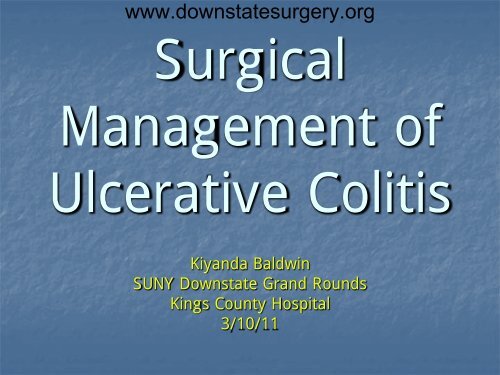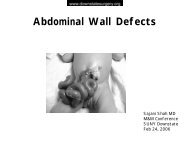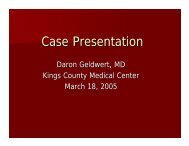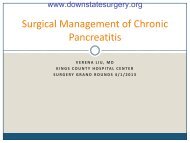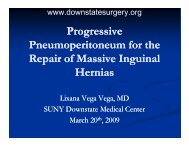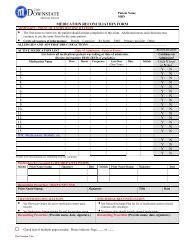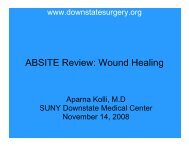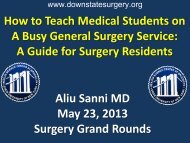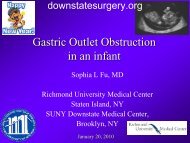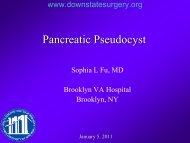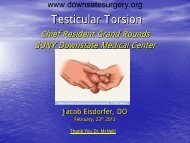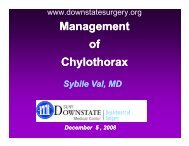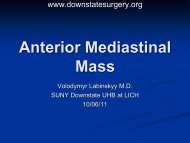Surgical Management of Ulcerative Colitis - Department of Surgery ...
Surgical Management of Ulcerative Colitis - Department of Surgery ...
Surgical Management of Ulcerative Colitis - Department of Surgery ...
You also want an ePaper? Increase the reach of your titles
YUMPU automatically turns print PDFs into web optimized ePapers that Google loves.
www.downstatesurgery.org<br />
<strong>Surgical</strong><br />
<strong>Management</strong> <strong>of</strong><br />
<strong>Ulcerative</strong> <strong>Colitis</strong><br />
Kiyanda Baldwin<br />
SUNY Downstate Grand Rounds<br />
Kings County Hospital<br />
3/10/11
www.downstatesurgery.org<br />
Patient Presentation<br />
• 54 y/o M h/o UC x16yrs last c-scope low<br />
grade dysplasia<br />
• PMH UC<br />
• PSH appendectomy<br />
• All nkda<br />
• Meds: prednisone, asacol, 6MP<br />
• FH NC<br />
• SH denies x3
www.downstatesurgery.org<br />
Patient Presentation<br />
• H/H 12/36.8<br />
• Alb 3.9<br />
• CXR wnl<br />
• CT minimal thickening <strong>of</strong> ascending & descending<br />
colon w/ pericolonic lymphadenopathy consistent w/<br />
chronic inflammation<br />
• UGI series WNL<br />
• C-scope pan colitis random Bx chronic inflam,<br />
cryptitis, low grade dysplasia
www.downstatesurgery.org<br />
Patient Presentation<br />
• Ex-lap, proctocolectomy, double-staple<br />
ileal J pouch anal anastomosis, intraop<br />
colonoscopy, diverting loop ileostomy<br />
• Path: pancolitis, low grade dysplasia<br />
• Now 1 month postop doing well
www.downstatesurgery.org<br />
<strong>Surgical</strong><br />
<strong>Management</strong> <strong>of</strong><br />
<strong>Ulcerative</strong><br />
<strong>Colitis</strong>
www.downstatesurgery.org<br />
Epiemiology<br />
• Incidence: 8-15/100,000<br />
• Incidence lower in Asia, Africa, S. America,<br />
& nonwhite Americans<br />
• Peaks in 3 rd & 7 th decades<br />
Schwartz 9 th ed, Maingot 11 th ed
www.downstatesurgery.org<br />
Etiology<br />
• Geographic differences suggest<br />
environmental (diet/infection)<br />
• Smoking, etoh, OCPs implicated<br />
• Genetic? 10-30% have + FH<br />
• autoimmune<br />
Schwartz 9 th ed, Maingot 11 th ed
www.downstatesurgery.org<br />
Pathophysiology<br />
• Poorly understood<br />
• Intestinal mucosa continually exposed to<br />
environmental challenge<br />
• chronic dysregulation <strong>of</strong> mucosal immunity<br />
• uncontrolled inflammatory response<br />
• IL-1B, 6, 8, TNF, prostaglandin (E2), leukotriene B4<br />
exacerbate mucosal inflammation<br />
• IL-4, 10 suppress intestinal inflammation<br />
Maingot 11 th ed
www.downstatesurgery.org<br />
Liu et al, Feb 2011<br />
• Sydney Australia; Neurogastroenterology Motility<br />
• Tachykinins, like substance P & neurokinin,<br />
hemokinin<br />
• Role in motility, secretion, and immune functions<br />
• Tachykinin receptor gene expression was 10-fold<br />
more abundant in colon mucosa <strong>of</strong> pts w/ UC<br />
compared to Control (p
www.downstatesurgery.org<br />
Pathology<br />
• Colonic mucosa & submucosa infiltrated w/<br />
inflammatory cells<br />
• Mucosal edema is the earliest manifestation<br />
• Ulcers are linear & knifelike<br />
• Atrophic mucosa & crypt abscesses common<br />
• mucosa is friable & may have inflammatory<br />
pseudopolyps<br />
• TI may demonstrate inflammatory changes<br />
(backwash ileitis)<br />
Schwartz 9 th edition
www.downstatesurgery.org<br />
Gross Pathology<br />
Mild<br />
<strong>Colitis</strong><br />
Severe<br />
<strong>Colitis</strong>
www.downstatesurgery.org<br />
Microscopic Pathology
www.downstatesurgery.org<br />
Lead Pipe Colon
www.downstatesurgery.org<br />
• Bloody diarrhea<br />
• Abdominal cramping<br />
• Tenesmus (proctitis)<br />
• Fulminant colitis<br />
Symptoms<br />
• Bloody diarrhea, severe abd pain,<br />
dehydration, high fever<br />
Schwartz 9 th edition
www.downstatesurgery.org<br />
Diagnosis<br />
• Colonoscopy<br />
• Mucosal biopsy<br />
Schwartz 9 th edition
www.downstatesurgery.org<br />
ndoscopy<br />
Mild<br />
Moderate<br />
Severe
Indications for Emergent <strong>Surgery</strong><br />
• Life threatening hemorrhage (1%)<br />
• Toxic megacolon (2.5%)<br />
• Fulminant colitis (15%)<br />
*pts who fail to respond to medical therapy<br />
*deterioration or failure to improve w/in 24-<br />
48hrs<br />
• Acute perforation<br />
• Obstruction due to stricture (11%)<br />
• Abdominal colectomy w/ ileostomy<br />
Schwartz 9 th ed, Maingot 11 th ed<br />
www.downstatesurgery.org
www.downstatesurgery.org<br />
Indications for Elective <strong>Surgery</strong><br />
• Intractability despite maximal medical<br />
therapy<br />
• High risk <strong>of</strong> complications from medical<br />
therapy<br />
• Significant risk <strong>of</strong> developing colorectal Ca<br />
Schwartz 9 th ed, Maingot 11 th ed
www.downstatesurgery.org<br />
Risk for Colorectal Ca<br />
• Increased w/ early age at Dx, increased<br />
duration, extent <strong>of</strong> Dz<br />
• Increased w/ duration<br />
• 2% after 10yrs & increases 0.5-1% annually<br />
afterward<br />
• 8% after 20yrs<br />
• 18% after 30yrs<br />
Schwartz 9 th edition, Maingot 11 th ed, Cameron 10 th ed
www.downstatesurgery.org<br />
Risk for Colorectal Ca<br />
• More likely to arise from areas <strong>of</strong> flat dysplasia<br />
making early Dx more difficult<br />
• => pts undergo (40-50) random Bx during<br />
colonoscopy<br />
• Annual surveillance after 8yrs for pts w/<br />
pancolitis, 15 yrs for pts w/ L. colitis<br />
• Ca may be present in up to 20% <strong>of</strong> pts w/ low<br />
grade dysplasia<br />
Schwartz 9 th edition, Maingot 11 th ed, Cameron 10 th ed
www.downstatesurgery.org<br />
Proctocolectomy &<br />
Ileostomy<br />
• Single stage<br />
• Curative<br />
• Incontinent<br />
• Use <strong>of</strong> collecting device<br />
• 20% morbidity:<br />
• Hemorrhage, sepsis, neural injury<br />
Maingot 11th ed
Subtotal Colectomy &<br />
Ileal-rectal Anastomosis<br />
• No need for stoma<br />
• Pelvic autonomic nerves are undisturbed<br />
• Not curative, 20% proctectomy<br />
• Contraindicated in pts w/<br />
• Anal sphincter dysfunction, severe rectal Dz,<br />
rectal dysplasia, or malignancy<br />
Maingot 11th ed<br />
www.downstatesurgery.org
www.downstatesurgery.org<br />
Continent Ileostomy/ Koch Pouch
www.downstatesurgery.org<br />
Continent Ileostomy/ Koch Pouch<br />
• 45-50cm <strong>of</strong> terminal ileum is used<br />
• The proximal 30-35cm is fashioned into a pouch<br />
• The outflow tract is intussuscepted & sutured/stapled<br />
creating a nipple valve<br />
• The reservoir is sutured to the peritoneum & fascia<br />
• The efferent limb is externalized as a flush stoma<br />
• Passing a s<strong>of</strong>t plastic tube through the nipple valve<br />
empties the pouch<br />
Maingot 11th ed
• Offered a curative resection and continence<br />
• Complicated by<br />
www.downstatesurgery.org<br />
Continent Ileostomy/ Koch Pouch<br />
• Nipple valve failure requiring revision 60%<br />
• Enteritis, pouchitis, nonspecific ileitis<br />
• Fat & B12 malabsorption<br />
• Neural and perineal wound problems similar to that<br />
<strong>of</strong> standard proctocolectomy<br />
• Still 2/3 are satisfied after 30 yrs<br />
Maingot 11th ed, Lepisto et al 2003
Total Proctocolectomy w/ Ileal<br />
Pouch-Anal Anastomosis<br />
• End to end ileal-anal anastomosis at the dentate<br />
line<br />
• Benefits<br />
• Preserve parasympathetics<br />
• Preservation <strong>of</strong> the anorectal sphincter<br />
• Elimination <strong>of</strong> the perineal proctectomy<br />
• Permanent ileostomy not required, maintains continence<br />
• High stool frequency<br />
www.downstatesurgery.org<br />
• Diverting loop ileostomy<br />
Maingot 11th ed
www.downstatesurgery.org<br />
Total Proctocolectomy w/ Ileal<br />
Pouch-Anal Anastomosis<br />
• R/O Crohn’s or other pathology preop<br />
• Colonoscopy & biopsy<br />
• UGI series<br />
• Intraoperative palpation <strong>of</strong> SB
Operative Technique <strong>of</strong><br />
• Lithotomy<br />
• Midline incision<br />
• Colon mobilization<br />
www.downstatesurgery.org<br />
IPAA<br />
• Transect ileum ~1-2cm proximal to ICV<br />
• Ileocolic A & colonic mesentery serially clamped,<br />
divided, & ligated<br />
• Rectal mobilization to the levator ani sling<br />
• Transect rectum 1-2cm above dentate line<br />
Maingot 11th ed
A. J-pouch, B. S-pouch, C. Side-to-side isoperistaltic pouch, and<br />
D. W-pouch<br />
www.downstatesurgery.org<br />
Ileal Pouch Construction
www.downstatesurgery.org<br />
Ileal<br />
J-Pouch
www.downstatesurgery.org<br />
Ileal J-Pouch<br />
• 15-20cm <strong>of</strong> the stapled <strong>of</strong>f TI is folded onto itself in the<br />
shape <strong>of</strong> a J<br />
• The distal/efferent limb is secured to the afferent limb<br />
• The pouch is formed using sequential firings <strong>of</strong> a 75-mm<br />
mechanical stapler applied through an enterotomy in the<br />
apex <strong>of</strong> the pouch<br />
• Pouch is filled w saline to check staple line (should hold 2-<br />
300cc)<br />
• Mobilize the SB mesentery so the pouch can reach the pelvis<br />
w/ no tension<br />
Maingot 11th ed
Hand Sewn<br />
www.downstatesurgery.org<br />
Ileal-anal Anastomosis
www.downstatesurgery.org<br />
Double-<br />
Staple<br />
Ileal-anal<br />
Anastomosis
Mucosectomy vs Double<br />
Staple<br />
• Double Staple = retained rectal mucosa => potential<br />
for proctitis & Ca<br />
• Double staple <br />
• Increased anal resting pressure<br />
• Preservation <strong>of</strong> the rectoanal inhibitory reflex<br />
• Improved continence<br />
• Fewer septic complications<br />
• Other studies have shown no difference<br />
• => surgeon’s preference<br />
www.downstatesurgery.org<br />
Maingot 11th ed, Hallgren et al 1995
Salient Points<br />
Pathophysiology still poorly understood<br />
Emergent surgery<br />
Hemorrhage, Toxic megacolon, Fulminant colitis,<br />
Perforation, Obstruction<br />
Subtotal colectomy w/ ileostomy<br />
Elective surgery<br />
www.downstatesurgery.org<br />
Intractability <strong>of</strong> symptoms, complications from<br />
medications, risk <strong>of</strong> Ca<br />
Total proctocolectomy w/ IPAA<br />
Total proctocolectomy w/ Ileal J pouch AA<br />
R/O other pathology preoperatively<br />
Provides curative surgery w/ continence
www.downstatesurgery.org<br />
References<br />
• Schwartz’s Principles <strong>of</strong> <strong>Surgery</strong>, 9 th Edition 2010<br />
• Current <strong>Surgical</strong> Therapy, 9 th Edition Cameron 2008<br />
• Maingot’s Abdominal Operations, 11 th Edition 2007<br />
• Liu L, Markus I, Saghire HE, et al. Distinct differences in tachykinin gene expression in<br />
ulcerative colitis, Crohn’s disease, and diverticular disease: a role for hemokinin-1?<br />
Neurogastroenterology Motility. no. doi: 10.1111/j.1365-2982.2011.01685.x<br />
• Larson DW, Pemberton JH. Current concepts and controversies in surgery for IBD.<br />
Gastroenterology 2004;126:1611–1619<br />
• Cheung O, Regueiro MD. Inflammatory bowel disease emergencies. Gastroenterol Clin<br />
North Am 2003;32:1269–1288 Lepisto AH, Jarvinen HJ. Durability <strong>of</strong> Kock continent<br />
ileostomy. Dis Colon Rectum 2003;46:925–928<br />
• Lepisto AH, Jarvinen HJ. Durability <strong>of</strong> Kock continent ileostomy. Dis Colon Rectum<br />
2003;46:925–928<br />
• Borjesson L, Oresland T, Hulten L. The failed pelvic pouch: conversion to a continent<br />
ileostomy. Tech Coloproctol 2004;8:102–105<br />
• Heppell J, Kelly KA, Phillips SF et al. Physiologic aspects <strong>of</strong> continence after colectomy,<br />
mucosal proctectomy, and endorectal ileal-anal anastomosis. Ann Surg 1982;195:435–443<br />
• Parks AG, Nicholls RJ. Proctocolectomy without ileostomy for ulcerative colitis. BMJ<br />
1978;2:85–88<br />
• Utsunomiya J, Iwama T, Imajo M et al. Total colectomy, mucosal proctectomy, and ilealanal<br />
anastomosis. Dis Colon Rectum 1980;23:459–466<br />
• Taylor BM, Cranley B, Kelly KA et al. A clinico-physiological comparison <strong>of</strong> ileal pouch-anal<br />
and straight ileoanal anastomoses. Ann Surg 1983;198:462–468<br />
• Hallgren TA, Fasth SB, Oresland TO, Hulten LA. Ileal pouch anal function after endoanal<br />
mucosectomy and hand sewn ileoanal anastomosis compared with stapled anastomosis<br />
without mucosectomy. Eur J Surg. 1995 Dec; 161(12):915-21<br />
• Farouk R, Pemberton JH, Wolff BG et al. Functional outcomes after ileal pouch-anal<br />
anastomosis for chronic ulcerative colitis. Ann Surg 2000;231:919–926
www.downstatesurgery.org<br />
Medical <strong>Management</strong> - Salicylates<br />
• Sulfasalazine<br />
• Inhibition <strong>of</strong> cyclooxygenase & 5-lipoxygenase in gut<br />
mucosa & => decrease inflammation<br />
• Pentasa(mesalamine), asacol, rowasa, canasa<br />
• remission 80% @3g/day<br />
• Sulfapyradine attached to 5-ASA which is cleaved by<br />
enteric bacteria inflammatory side effex<br />
• Oral, topical, or combo<br />
• Drug <strong>of</strong> choice for mild to moderate disease
www.downstatesurgery.org<br />
Medical <strong>Management</strong><br />
• Steroids<br />
• Moderate to severe<br />
• HTN, hyperglycemia, cataracts, osteoporosis,<br />
osteomalacia<br />
• Budesonide, beclomethasone undergo rapid<br />
hepatic degradation to limit systemic toxicity
www.downstatesurgery.org<br />
Medical <strong>Management</strong><br />
Immunosuppressive Agents<br />
• Azathioprine, 6-MCP<br />
• Interfere w/ nucleic acid synthesis<br />
• Good for those who failed salicylate Tx or are dependent on<br />
steroids (6-12 wk onset <strong>of</strong> axn)<br />
• Cyclosporine<br />
• Interferes w/ T cell funxn<br />
• Helps acute flares 80%<br />
• Methotrexate<br />
• Folate antagonist<br />
• Infliximab (Remicade)<br />
• Monoclonal Ab against TNF alpha<br />
• >50% w/ moderate to severe Dz respond
www.downstatesurgery.org<br />
Extraintestinal Manifestations<br />
• Liver most common: fatty liver 40-50% reverse by med<br />
or Sx, cirrhosis (2-5%) irreversible<br />
• Primary sclerosing cholangitis strixrs <strong>of</strong> intra &<br />
extrahepatic ducts (40-60% have UC) only effective<br />
therapy is liver transplant<br />
• Cholangiocarcinoma rare but pts r ~20yrs younger than<br />
typical pts w/ it<br />
• Arthritis improves w/ meds or Sx but sacroiliitis or<br />
ankylosing spondylitis does not<br />
• Erythema nodosum 5-15%, W:M 3-4:1, raised red & on<br />
lower legs & pyoderma grangenosum some may improve<br />
w/ Sx
www.downstatesurgery.org<br />
Post-IPAA<br />
• Barium enema & flex sig<br />
• Evaluate anal sphincter tone<br />
• Loop ileostomy reversed


